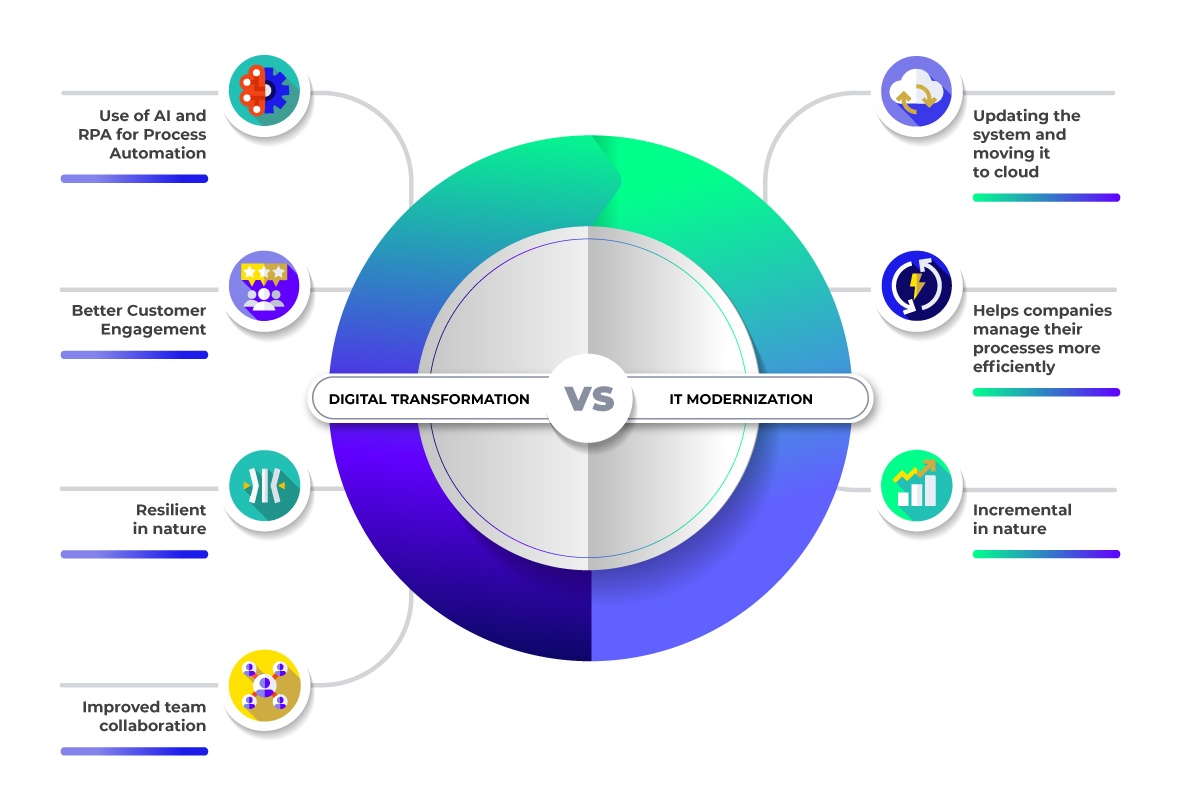
In today’s dynamic business landscape, organizations face numerous challenges such as economic volatility, supply chain complexities, evolving work styles, competing for talent, fickle consumer trends, market commoditization, sustainability concerns, and more. As stated in Forrester Research’s 2021 report, “In the 2020s, the one constant will be disruption.” CIOs play a crucial role in navigating these challenges and driving business transformation. The ability to embrace disruption will set leaders apart from laggards in this ever-changing landscape.
In this context, it is important for technology executives to make the choice between modernizing legacy processes or instituting a complete transformation of their systems. Yet, many organizations struggle to understand the difference.
In this article, we explore both digital transformation and modernization and why transformation is mission-critical for modern businesses.
Digital Transformation Vs. IT Modernization
Digital transformation has a broader scope and touches almost every facet of a business. IT modernization’s scope is limited to upgrading existing systems.
Don’t get us wrong. Modernizing your tech stack is just as critical to your business as transformation. The 2023 CEO Priorities survey shows that 51% of CEOs think low digital maturity/technical capabilities are barriers to creating business value with AI. As companies try to achieve digital maturity, they’ll go through multiple IT modernization iterations.
Let’s dig into the differences between digital transformation and IT modernization.
Digital Transformation in Practice
A digital transformation is meant to change or evolve some of the DNA of an organization such that a company is better equipped to compete in a constantly evolving environment where customer expectations are changing at breakneck speed. Technology can and should play a central role in a digital transformation but technology alone will not equip a company to operate effectively in this “new normal”, this requires a careful choreography of people, processes, and technology.
In addition to being better equipped to meet evolving customer needs and expectations, digital transformation can be your doorway to scaling your business by entering new markets, eliminating or minimizing process inefficiencies, and becoming more agile.
Domino’s is an excellent example of how digital transformation can change your company’s growth trajectory. Back in the day, the pizza chain was a brick-and-mortar restaurant that promised to deliver pizzas in under 30 minutes.
Competitors started offering a similar service. So Patrick Doyle, the CEO of Domino’s in 2011, decided to create an app that allowed customers to order pizza within seconds. Currently, Domino’s is testing delivery via autonomous vehicles to stay ahead of delivery services like DoorDash and Uber Eats.
Essentially, digital transformation involves a fundamental shift in various business aspects, like internal processes and your business model. The goal is to achieve sustained growth and become a more competitive business.
Modernization in Practice
Modernization is often confused with digital transformation, but they are not the same. Modernization focuses on building on top of existing systems. For example, you could implement cloud computing and AI without changing legacy processes.
Suppose you’re a bank that is looking to improve its mortgage origination process. You currently require staff to enter customer details manually. Over the next quarter, you want to implement an automated loan origination system that eliminates almost all the mundane tasks in the origination process.
For this, you’ll use technologies like AI, natural language processing (NLP), optical character recognition (OCR), and robotic process automation (RPA) through third-party integration or by building a new solution. These technologies will enable you to automate tasks like document processing and customer onboarding.
These technologies can help you re-engineer the origination process to make it more efficient—without disturbing your underlying mortgage process or the business model.
Why Digital Transformation Matters
Digital transformation is right for you if you’re in a rapidly evolving market and want to stay ahead of the competition.
Since digital transformation involves a more comprehensive change in your business’s model and operational processes, it can be resource and time-intensive, especially in the absence of first-hand experience on the multi-faceted nature of transforming an organization. Let’s go back to our mortgage example to understand the difference between transformation and modernization. Consider if the mortgage lender wanted to move from being a traditional, broker-based lender to a digital direct lender and the relative time, cost and complexity required to stand up a whole new business model.
IT modernization is relatively less resource and time-intensive. Modernization is an excellent place to start if you’re struggling to meet customer expectations or efficiency targets because of outdated technology.
Revamping your technological systems will help you reduce costs, operate more efficiently, and scale your business.
Digital transformation matters to two types of businesses:
- Businesses that want to stay ahead of the curve by implementing the latest technologies in a fast-evolving market.
- Businesses that need to survive in a market where other businesses failed to implement new technologies on time.
Digital transformation isn’t easy for either of these businesses to implement without an experienced team—only about 30% of companies navigate digital transformation successfully.
However, once you’ve successfully completed digital transformation, your business stands to benefit on multiple fronts.
The pandemic caused the most recent surge in digital transformation. Businesses were forced to adapt to an environment where employees prefer remote or hybrid work models, but they benefited greatly from the changes that followed.
That’s exactly why more businesses are excited about digital transformation. In fact, according to the World Economic Forum, the combined value of digital transformation to society and industry will exceed $100 trillion by 2025.

Here are some benefits of digital transformation that highlight why it can be a game changer for your business this year:
Improves Customer Experience
Customer expectations have risen significantly over the past decade. They prefer businesses that offer a great experience in all customer-facing aspects.
Enable Data-Driven Decision Making
Data analytics is one of the most critical capabilities you gain from digital transformation. With modern tech, it is typically much easier to securely access and manipulate data that can be used to unlock valuable insights about customers, competitors, and internal processes.
Better Resource Management
Digitally-powered businesses use hundreds of apps and store data in multiple places. The lack of interoperability and data silos can make business hard. Digital transformation involves integrating these digital tools, allowing you to consolidate dispersed data sets and apps.
Improves Team Collaboration
Adding the right digital collaboration tools to your toolkit can be critical to building a collaborative environment in the workplace. They allow teams to collaborate outside the office space or country. If your team is spread across time zones, you can use async communication tools for better collaboration.
Increases Scalability
Digital transformation gives you the flexibility to grow faster. It can help reduce time to market and make product or service improvements faster. You can also serve clients in a larger geographic area and communicate with your clientele more effectively.
What Does it Take to Create Digital Transformation?
Digital transformation needs more than just technical expertise. It’s a massive undertaking where multiple factors contribute to your success.
Here are things to focus on when transforming your business digitally:
Digital First Culture
Transforming your business requires agility and an attitude to pursue the latest technologies proactively. Building a digital-first culture, where employees proactively look for opportunities to use digital solutions to help the business achieve its goals, is critical to successfully transforming your business.
Culture is a critical part of Gartner’s ContinuousNEXT approach to digital transformation. The Gartner experts who coined the term cite culture as a major barrier — 46% of CIOs identify culture as the most significant barrier to digital transformation.
A report by MIT and Capgemini explains that focusing on the following seven cultural attributes can be vital to building a digital-first culture:
- Innovation: The prevalence of behaviors that support taking risks, thinking disruptively, and exploring new ideas.
- Digital-first mindset: A mindset where everyone, by default, thinks of digital solutions first.
- Customer-centricity: The use of digital tools to improve customer experience, expand the customer base, and co-create new products.
- Open culture: The extent of partnership with third parties, including vendors and customers.
- Agility and flexibility: Decision-making speed, dynamism, and your company’s ability to adapt to evolving market demands and technologies.
- Data-driven decision-making: The use of data to make better decisions.
- Collaboration: The strategic creation of teams to make the best use of the company’s human resources.
Change Management
Often, the most overlooked aspect of a digital transformation is the amount of change management and capability development required to enable team members to excel in their new or evolved roles. One takeaway that we’ve learned from our experience is the need to have a strong leadership commitment and a high level of conviction and alignment across the senior leadership team on the transformation objectives, priorities, and plan to undertake the transformation effort at an organization. .
When communicating a change, remember that the benefits of change may be evident to you. Yet, your team might see change as a signal to step out of a workflow they’re comfortable with and learn new skills.
Resistance will snowball when one employee who feels that way communicates with colleagues. Change management can help prevent or at least minimize this resistance to change.
Here are three critical elements of managing change:
- Plan before you start: Change management should start before digital transformation. Risk analysis and assessing the organization’s readiness are great ways to lay the foundation for your change management strategy. They involve identifying organizational attributes like culture and characteristics of change.
- Change management: This is where you go from planning to execution. You keep communicating your digital transformation plans, address concerns regarding the plan, and train employees.
- Feedback: Change management doesn’t end after executing your change management strategy. Seek feedback from employees about the change. If you see reluctance, take corrective actions to ensure resistance doesn’t snowball.
Data-Driven Organization
Digital transformation is highly data-driven. Managing data — storing and processing data and ensuring data integrity — are one of the first things you’ll need to work on when you start the digital transformation process.
Data provides a unique insight into your operations. Once you’ve achieved a higher level of operational transparency and gained a deeper understanding of core business processes using data, you’ll be able to identify barriers to digital transformation. Data will also enable you to improve and optimize your transformation strategy continuously.
Companies like Airbnb and Amazon hold massive volumes of data. These companies are great examples of data-driven organizations. This data allows them to personalize customer experiences and stay one step ahead of the competition.
Emphasis on Quality
When you’re adamant about delivering quality, you’ll need to ask yourself — is the business prepared to ensure a high level of quality during the digital transformation journey?
Going all in at once is a bad idea. Digital transformation requires an incremental approach where you plan, test, and validate ideas every step of the way. This will allow you to stay prepared for potential pitfalls and optimize your strategy as you go. You’ll avoid complete disasters, which can result in loss of money, trust, and reputation.
Taking an incremental approach makes your digital transformation journey smoother and ensures you maintain high quality throughout the transformation process.
Begin Your Digital Transformation Journey
Digital transformation can be challenging to navigate without an experienced partner.
At Blanc Labs, we understand each organization has unique needs. We offer advisory and consulting services to gain a complete understanding of your most pressing challenges and help you start your digital transformation journey.
Book a discovery call with us today to learn more.